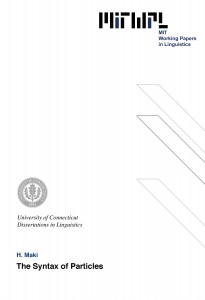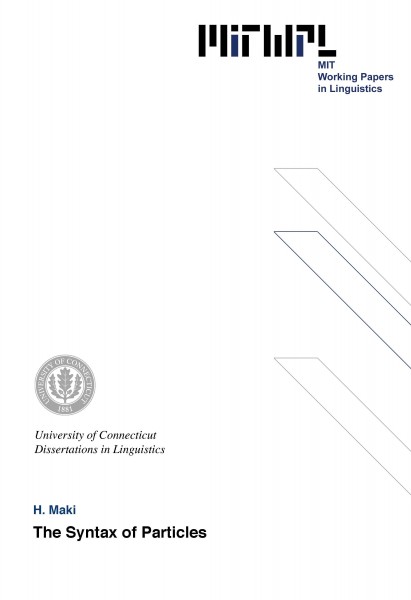The Syntax of Particles
H. Maki, 1995
Abstract (Summary)
The purpose of this thesis is to give support to the feature movement hypothesis proposed in Chomsky (1995). In this hypothesis, operations just apply to features, and the appearance that categories are affected by operations in overt syntax follows from PF requirements. Then, LF movement, which is free from PF requirements, must be restricted to feature movement in principle.
In Chapter 2, I examine Japanese wh-constructions, and show that the properties directly follow from the hypothesis that for an argument wh-phrase, only the wh-feature moves to the (+Q) COMP in LF. Specifically, this hypothesis gives an account for the fact that there are no CED/Complex NP Constraint effects for argument wh-phrases in situ. One of the implications of the hypothesis is that there is no pure wh-operator for a wh-phrase in Japanese in the sense of Watanabe (1992).
Under the pure wh-operator movement hypothesis, Watanabe gives an account for what he calls the "anti-superiority" effects in Japanese. In Chapter 3, I consider the effects under the feature movement hypothesis, and argue that these follow from the Operator Disjointness Condition proposed in Lasnik and Saito (1992), with a slight revision, and the LF adjunction hypothesis advocated in Saito (1992).
In Chapter 4, I examine the nature of even (and its Japanese counterpart sae), and show that it is associated with scope. Based on the scope facts, I propose that a construction with even involves movement of a null operator. The question arises why the null operator moves rather than its feature. I suggest that for a proper interpretation of the chain, a variable must exist in the tail of the chain, and there is a restriction on variables.
Table of Contents:
Chapter 1: Introduction.........................................................................................................................1
1.1 Introduction.................................................................................................................................1
1.2 Toward Attract-F.........................................................................................................................3
1.2.1 Rizzi (1990) ....................................................................................................................3
1.2.2 Chomsky and Lasnik (1993) and Takahashi ..............................................................6
1.2.3 Chomsky (1995) ............................................................................................................10
1.3 Visibility ......................................................................................................................................18
1.4 Organization .............................................................................................................................32
Chapter 2: KA and MO ...........................................................................................................................35
2.1 Introduction ...............................................................................................................................35
2.2 Previous Analyses .....................................................................................................................36
2.2.1 Huang (1982) and Tsai (1994) ....................................................................................36
2.2.2 Nishiguachi (1986) and Hoji (1983) ...........................................................................42
2.2.3 Watanabe (1992) .........................................................................................................48
2.3 Some Problems ..........................................................................................................................64
2.3.1 The Pied – Piping Mechanism .....................................................................................64
2.3.2 Radical Reconstruction ..............................................................................................66
2.4 Proposal and Analysis .............................................................................................................71
2.5 Conclusion ................................................................................................................................104
Chapter 3: Superiority .........................................................................................................................106
3.1 Introduction .............................................................................................................................106
3.2 The Problems ...........................................................................................................................107
3.3 Proposal and Analysis .............................................................................................................112
3.3.1 Superiority ...................................................................................................................112
3.3.2 The LF Adjunction Hypothesis ..................................................................................123
3.4 Conclusion ................................................................................................................................125
Chapter 4: Even/Sae ............................................................................................................................127
4.1 Introduction .............................................................................................................................127
4.2 Scope Properties of Even/Sae ...............................................................................................130
4.3 Category Movement under Attract – F ................................................................................147
4.4 Conclusion ................................................................................................................................153
Bibliography ..........................................................................................................................................155

